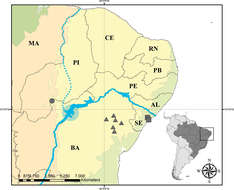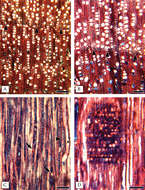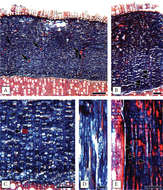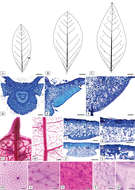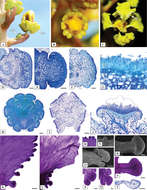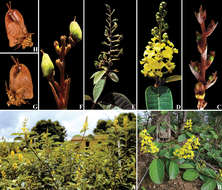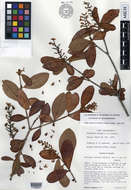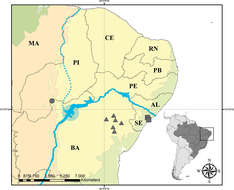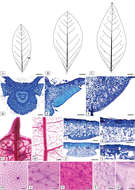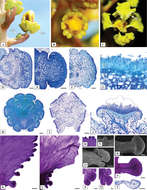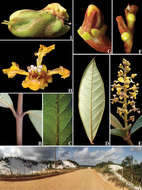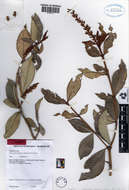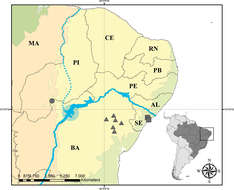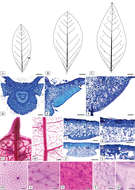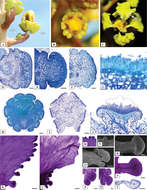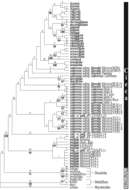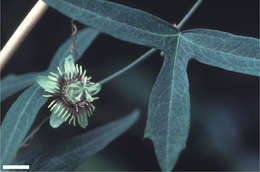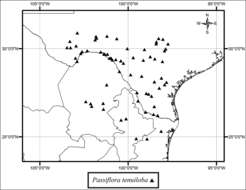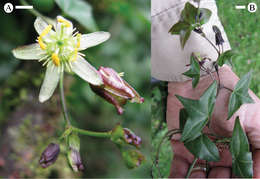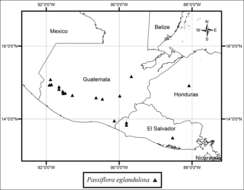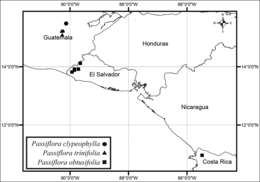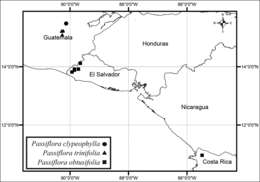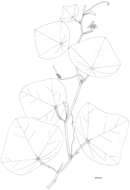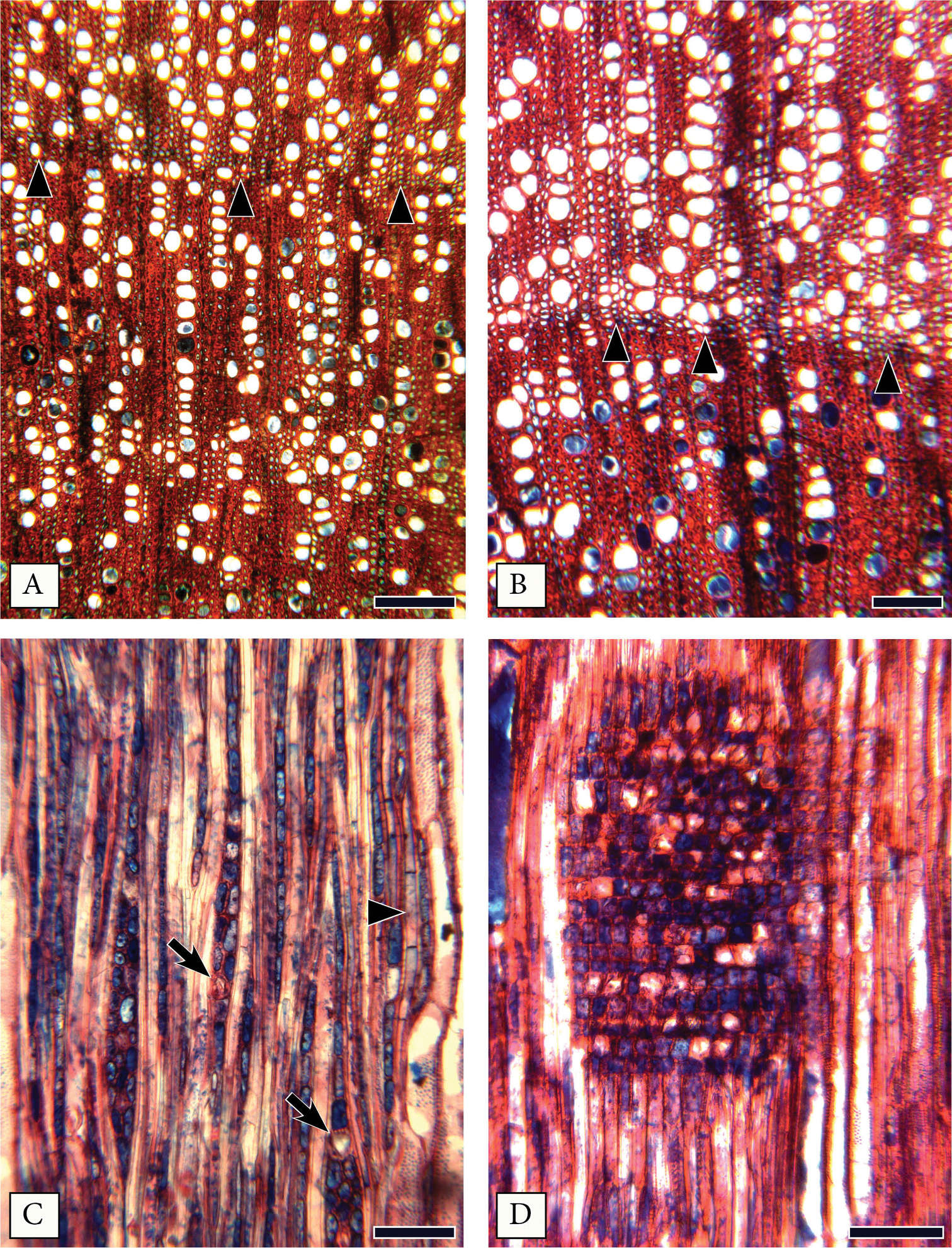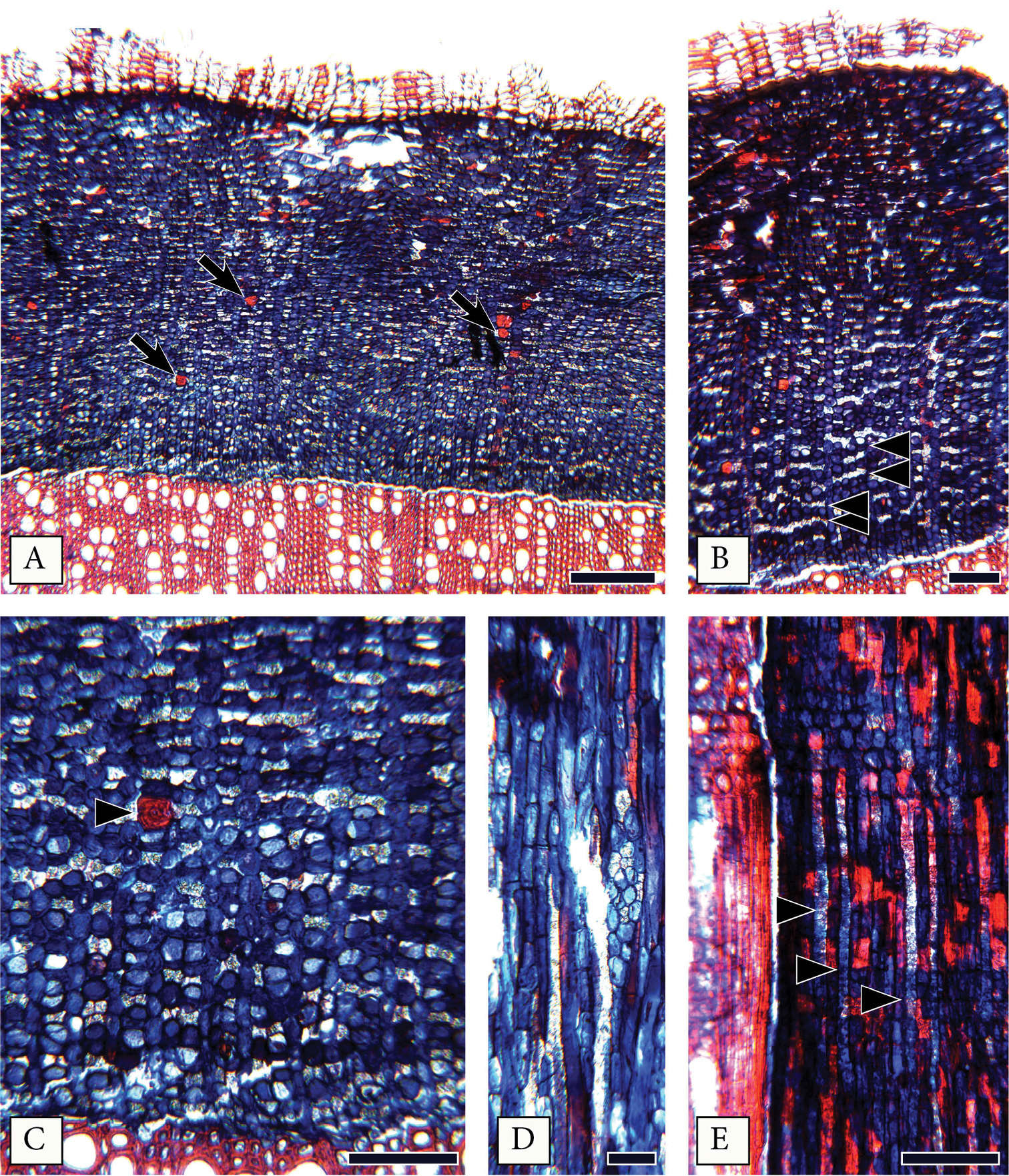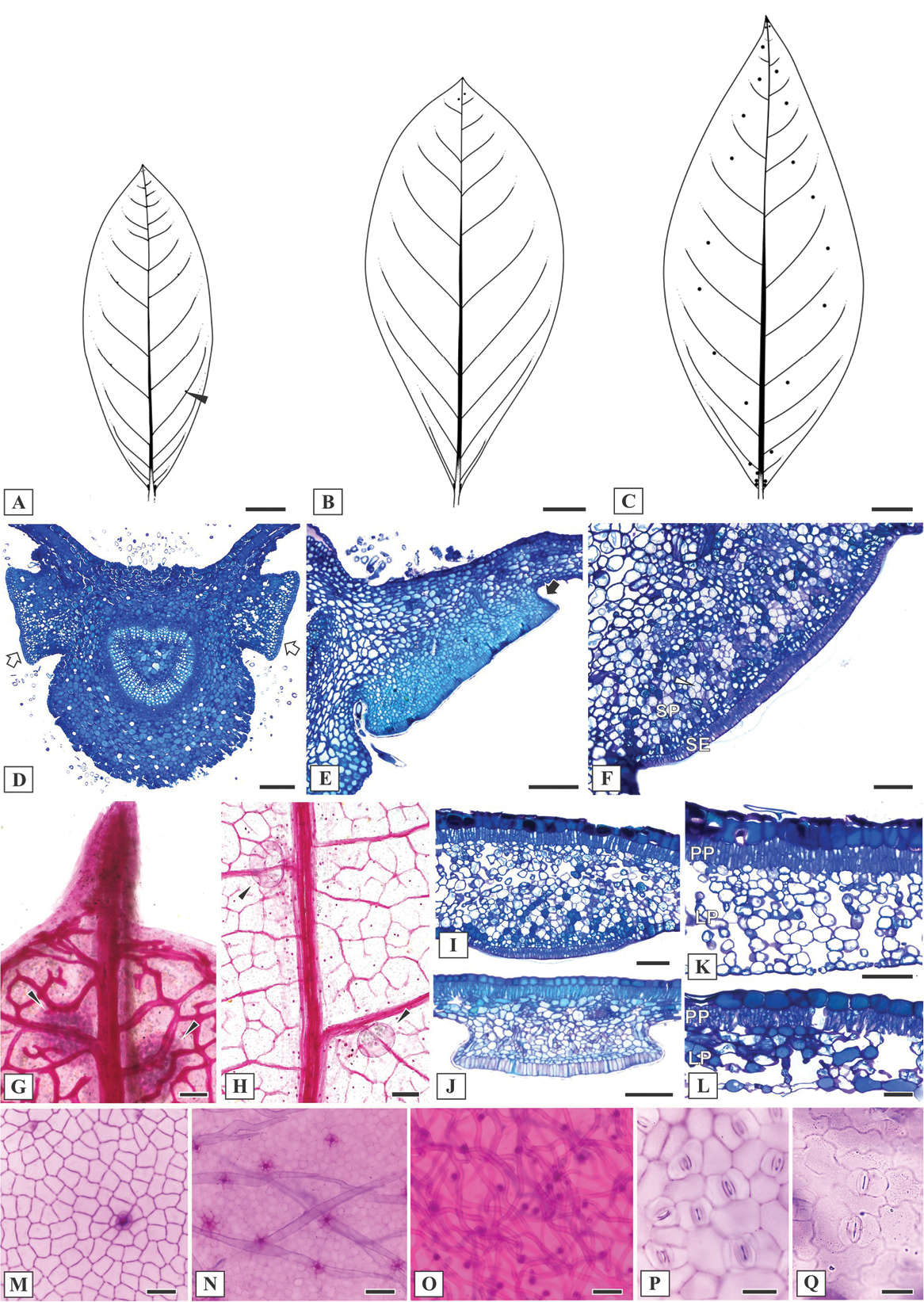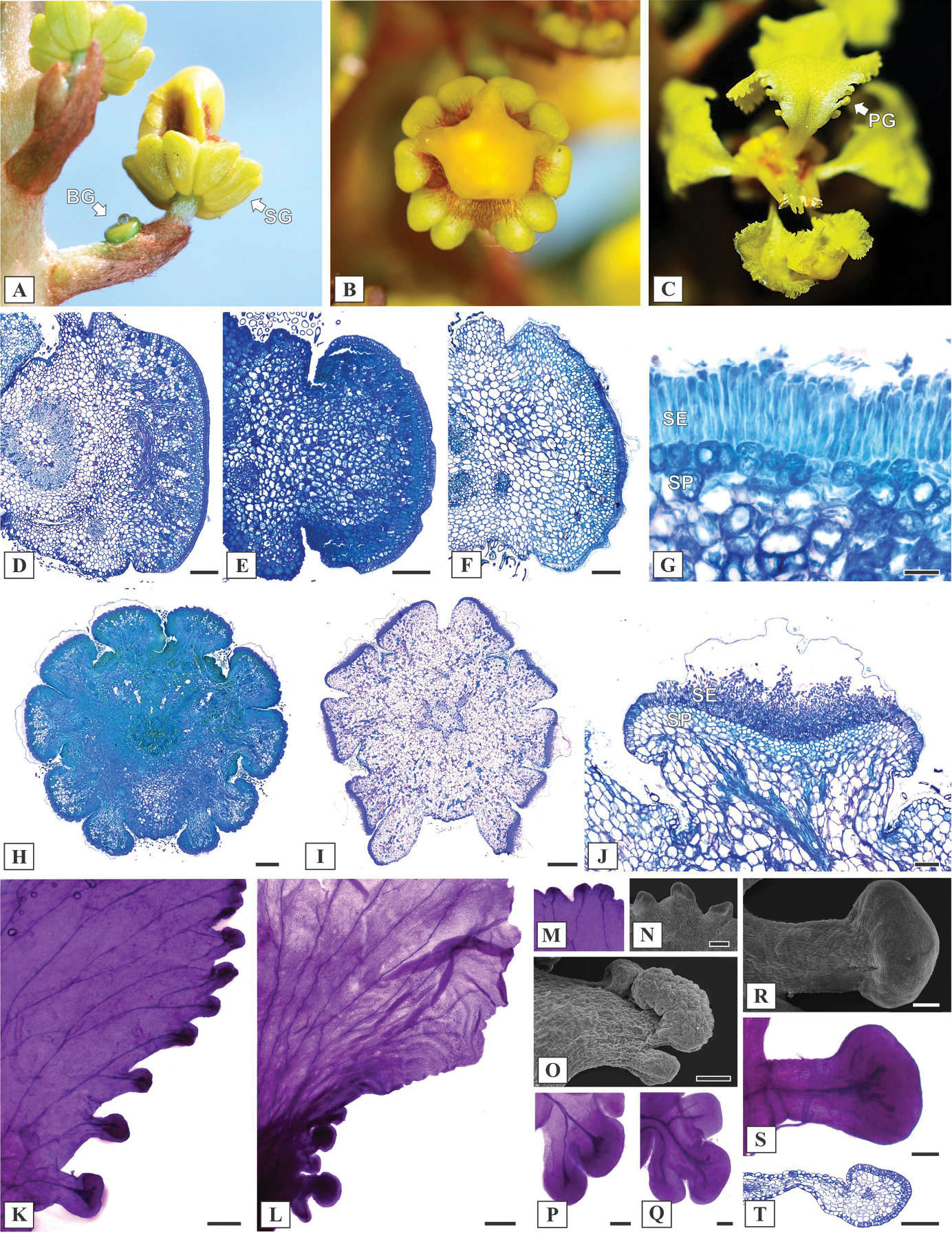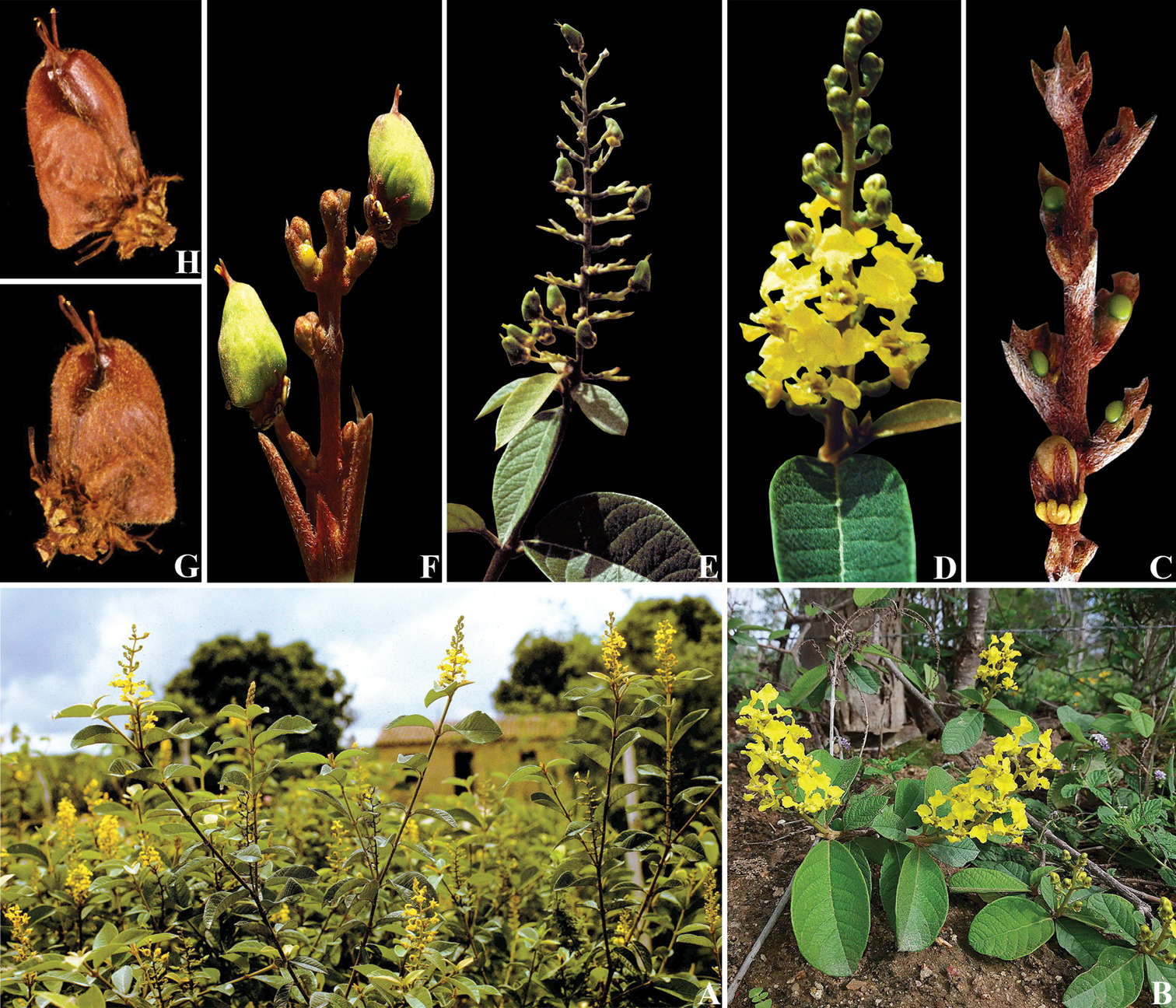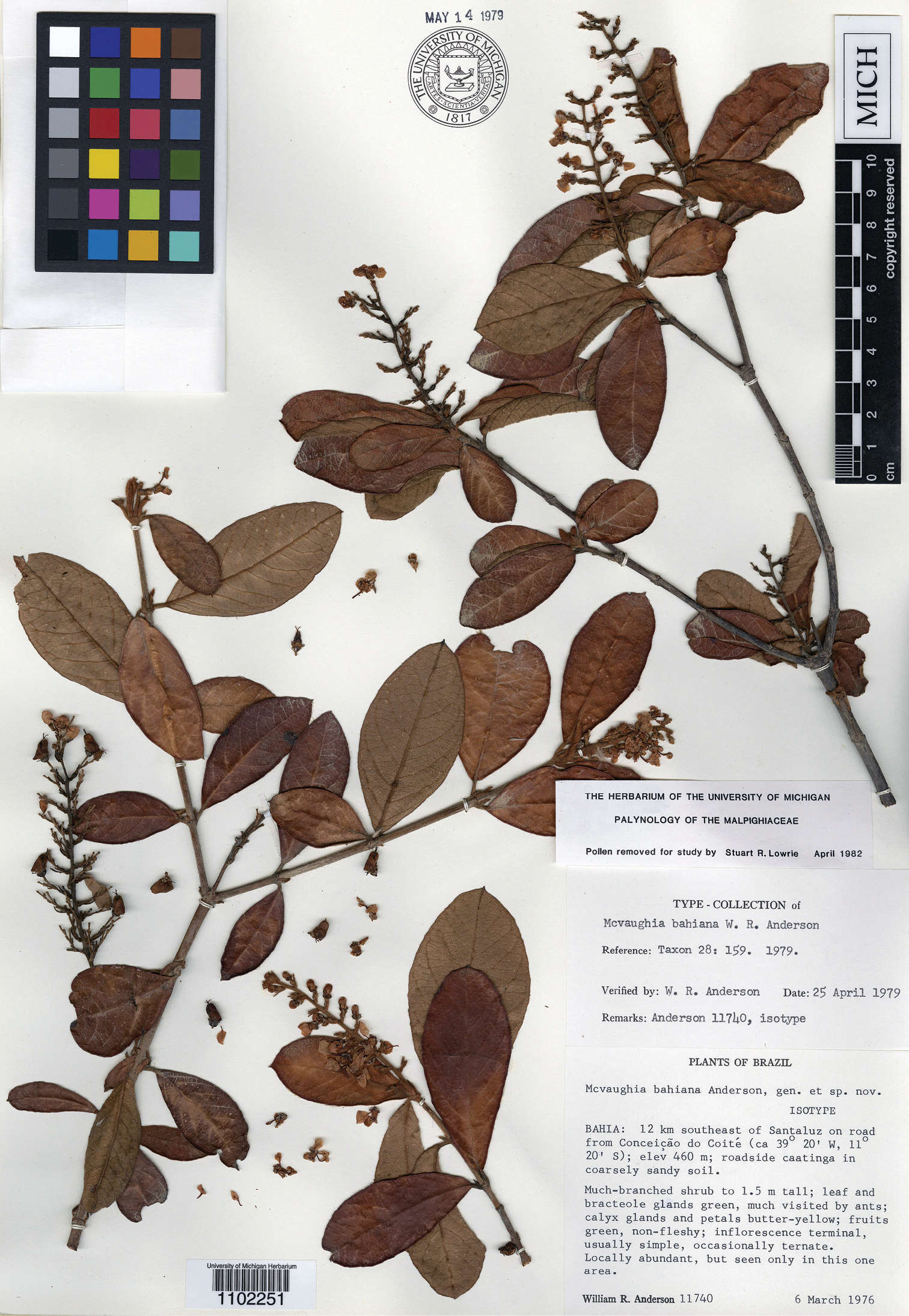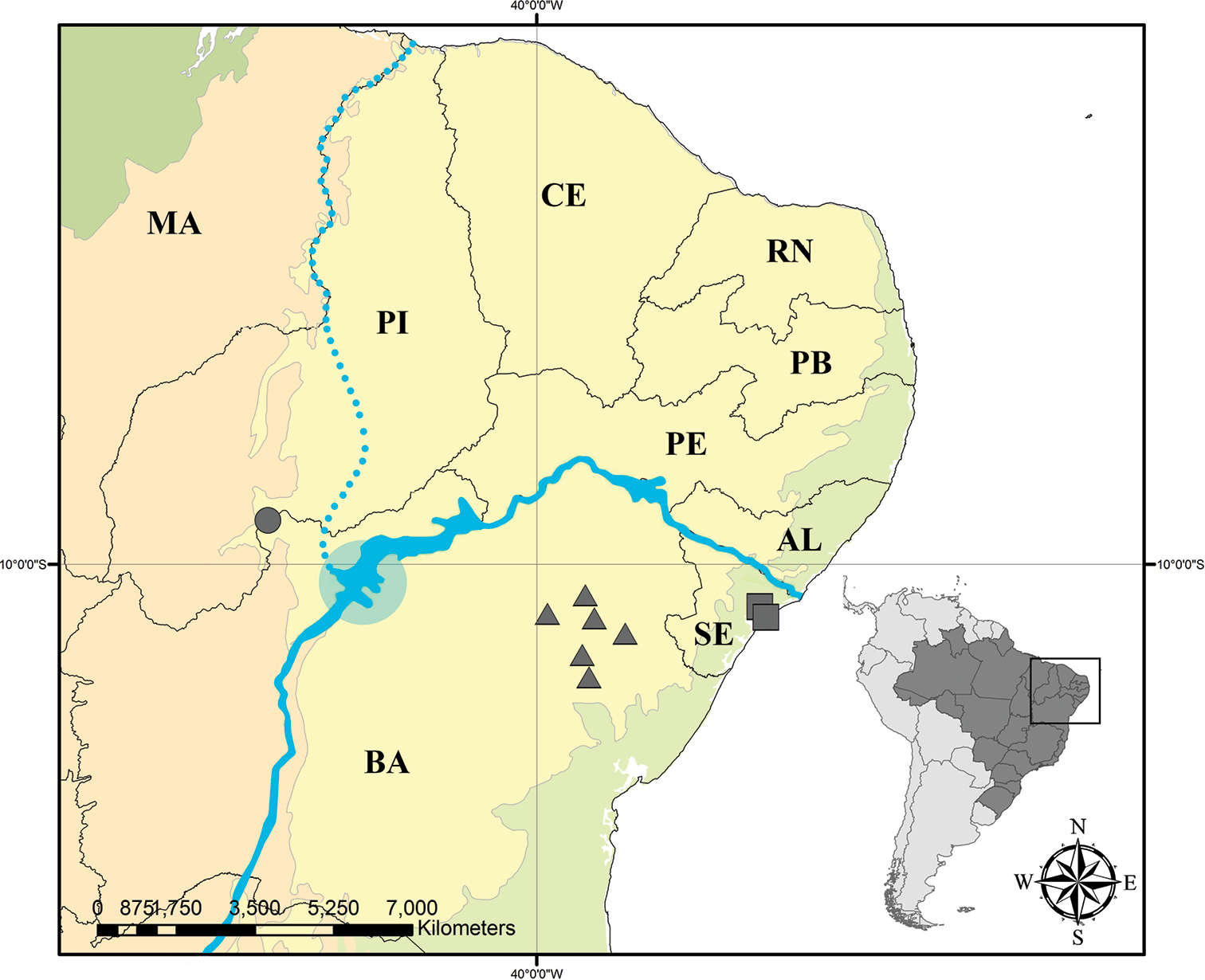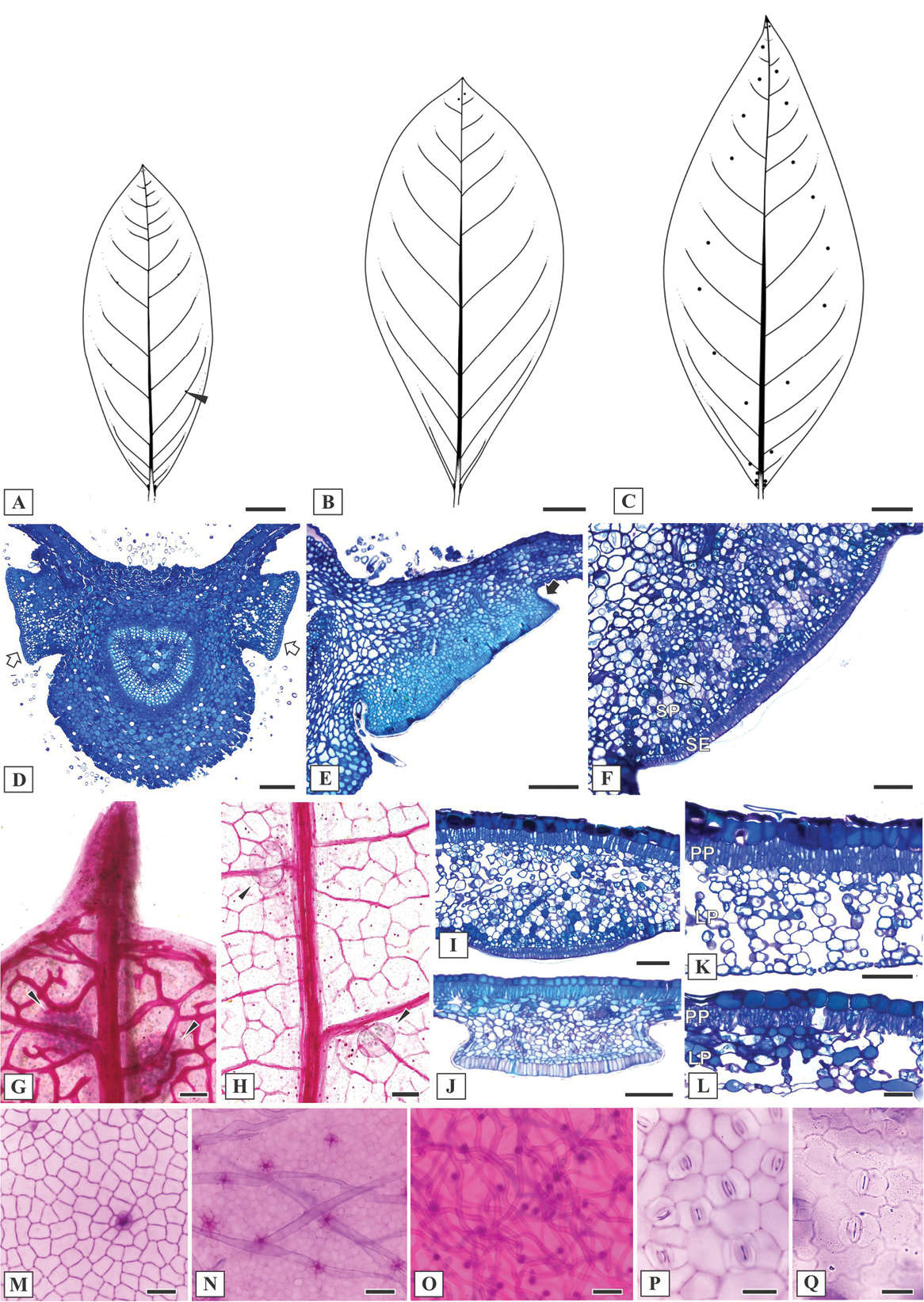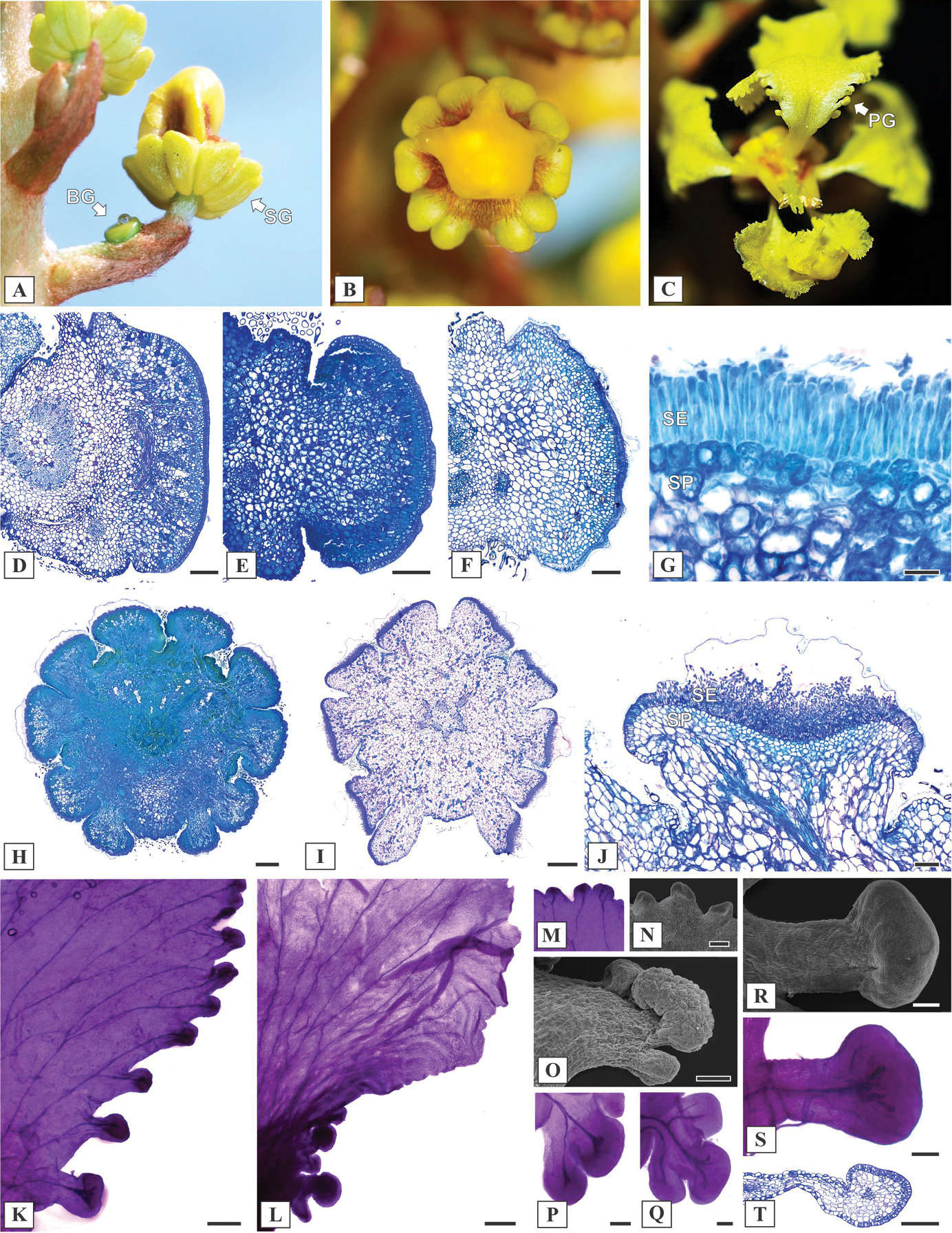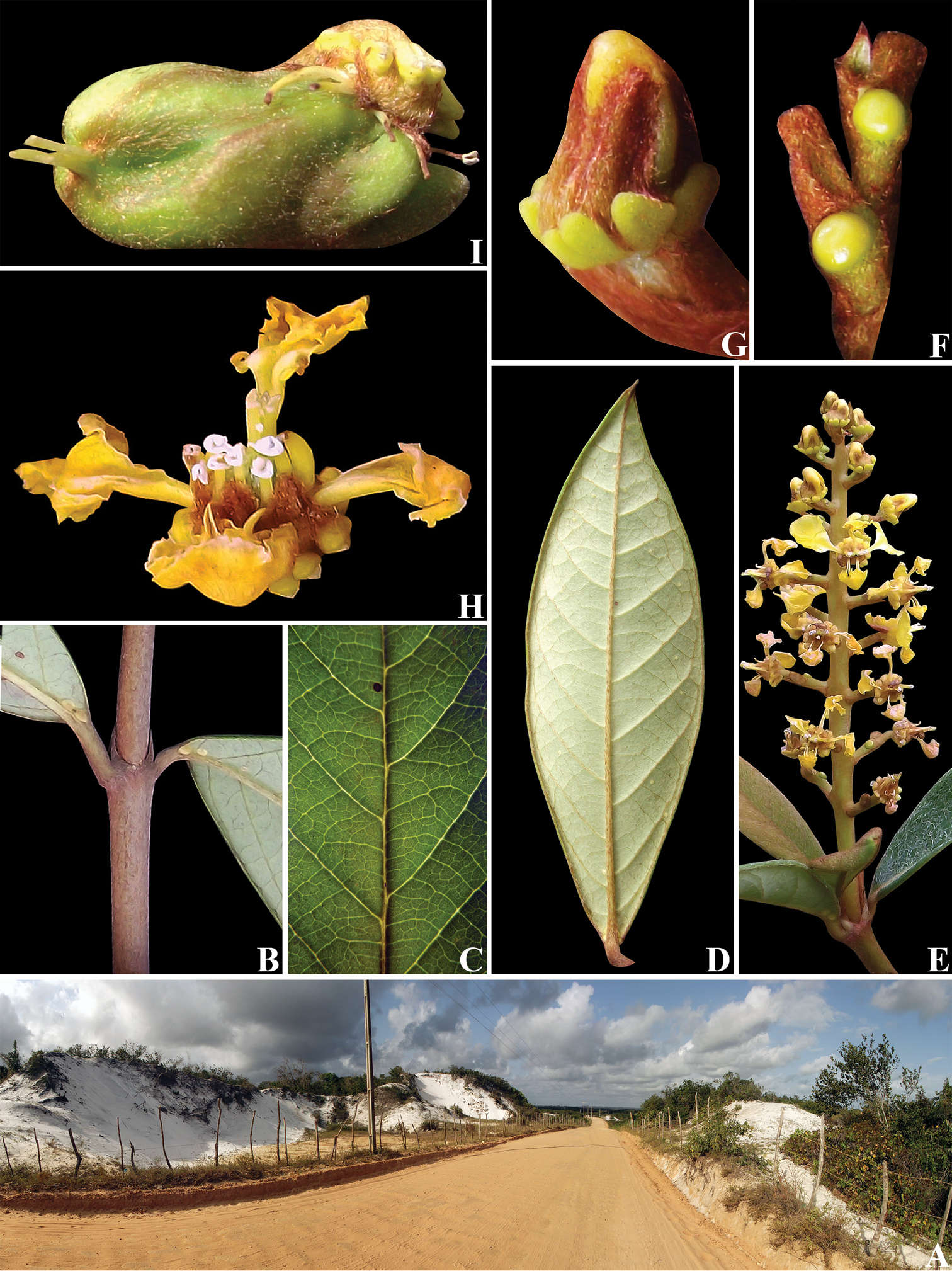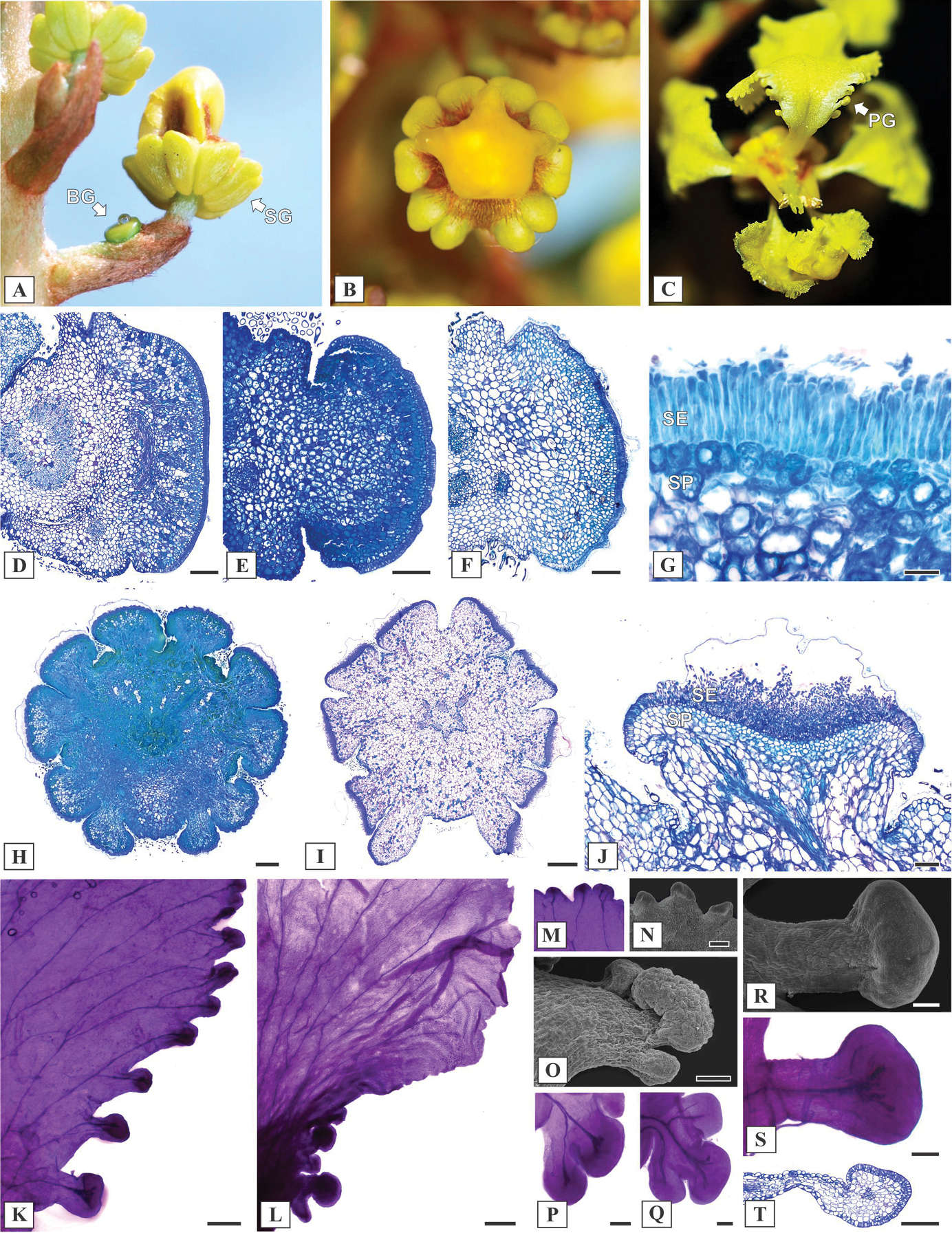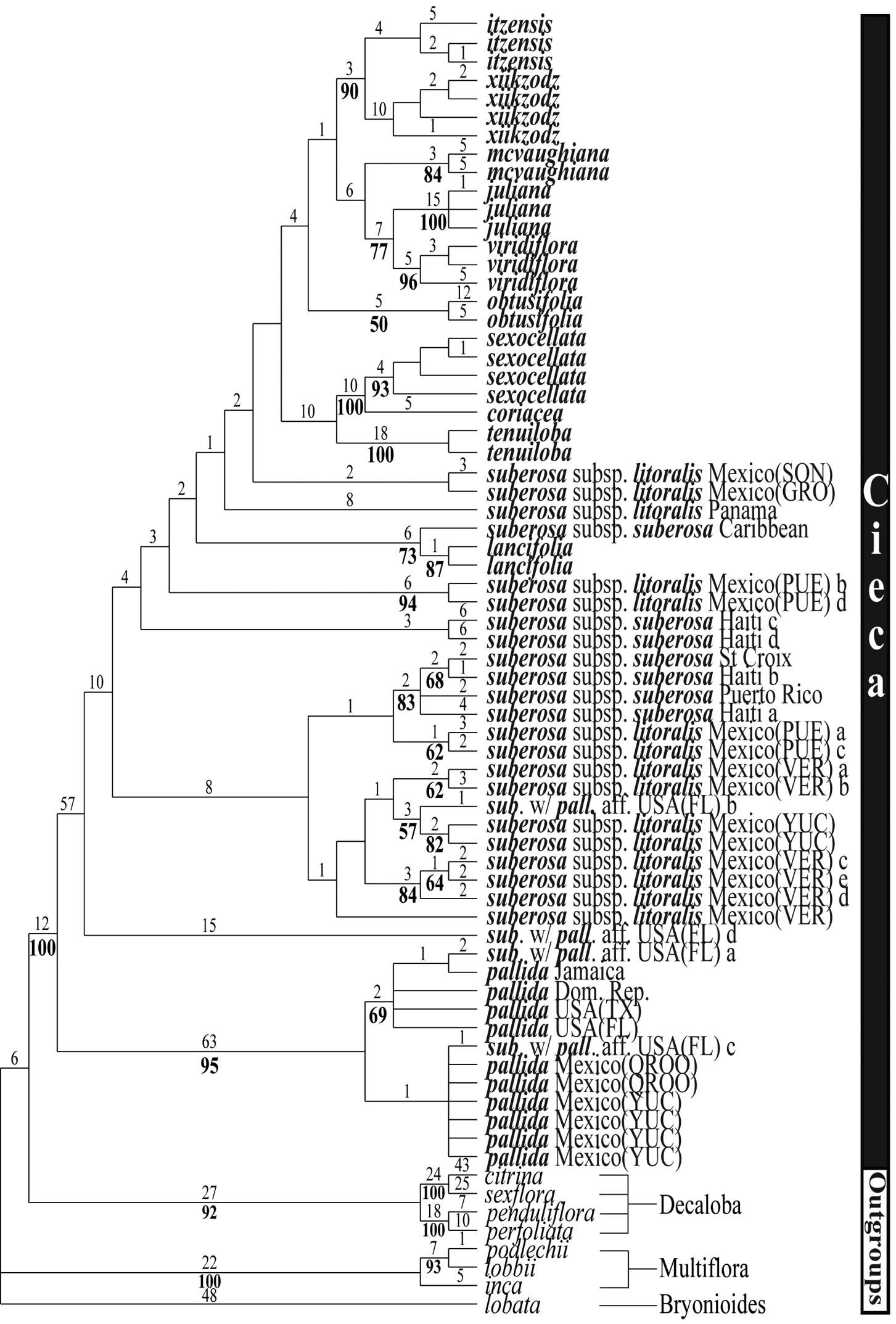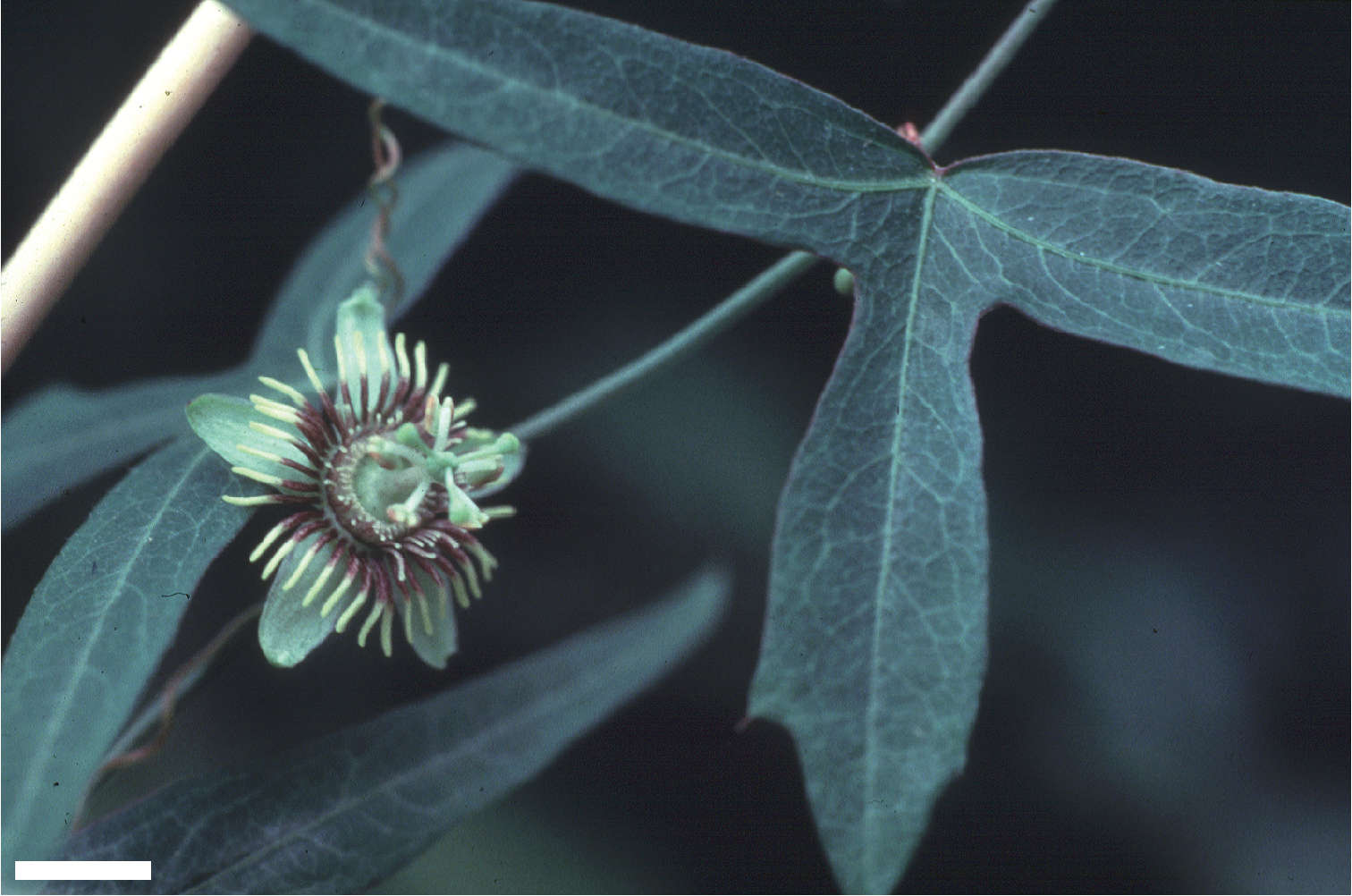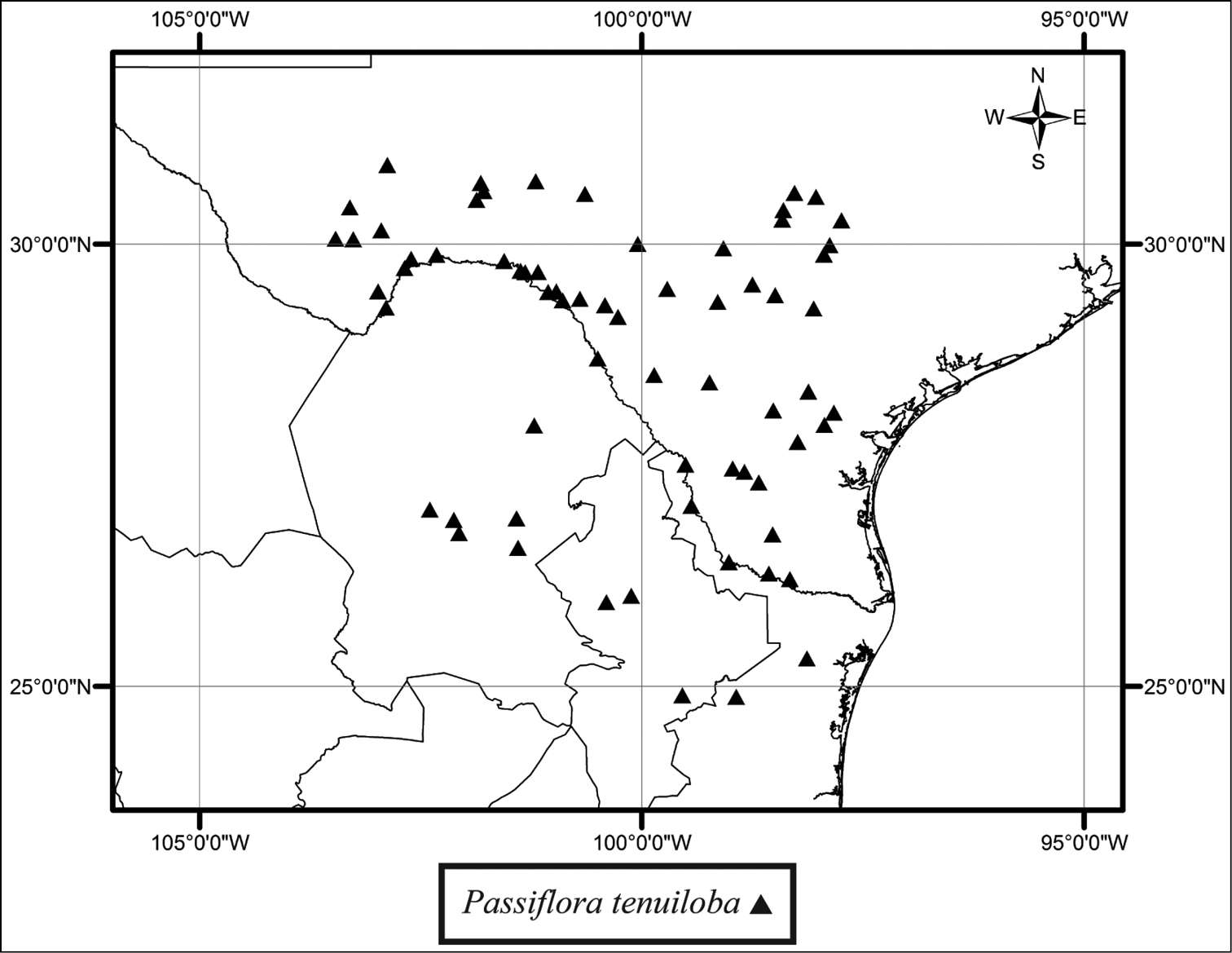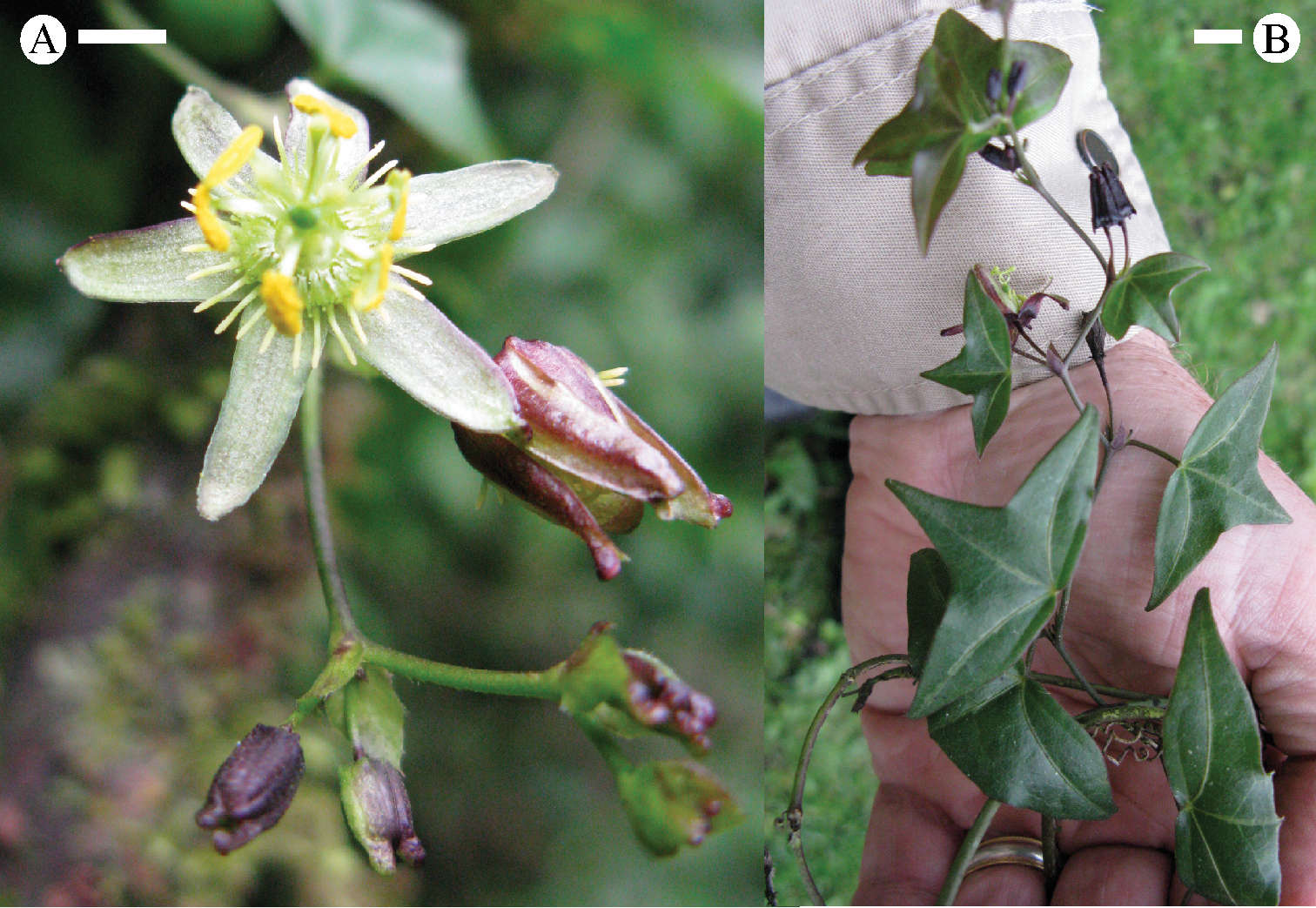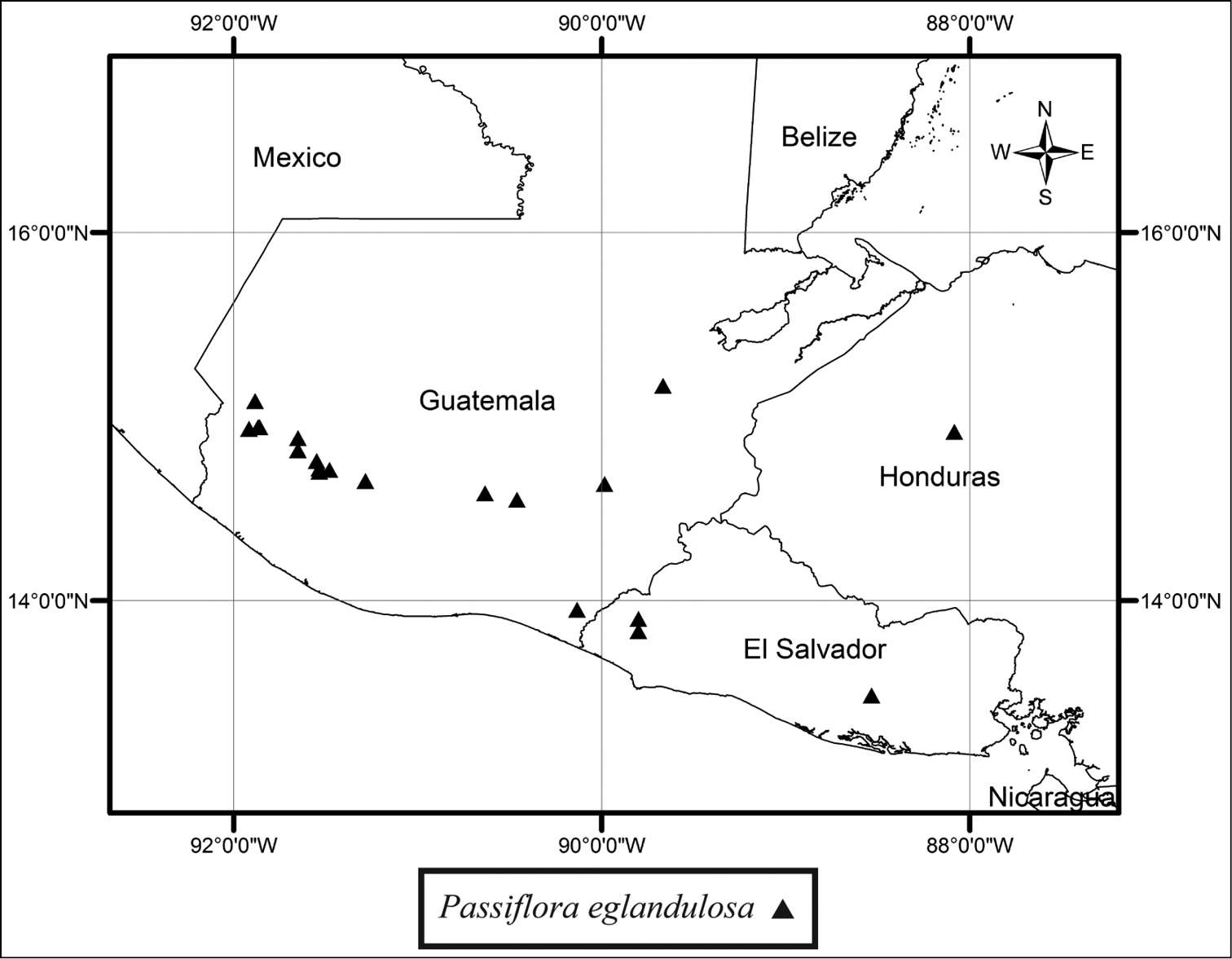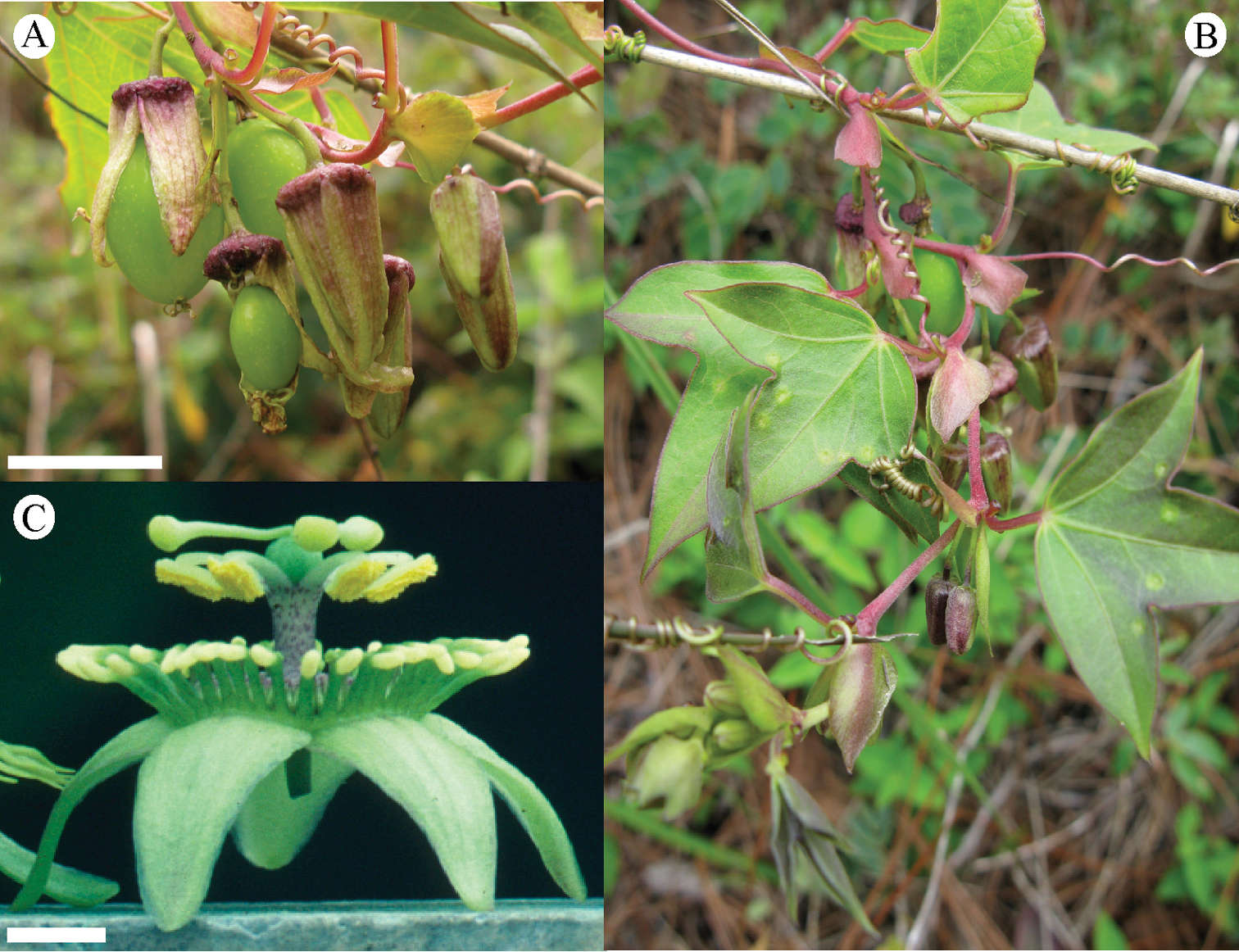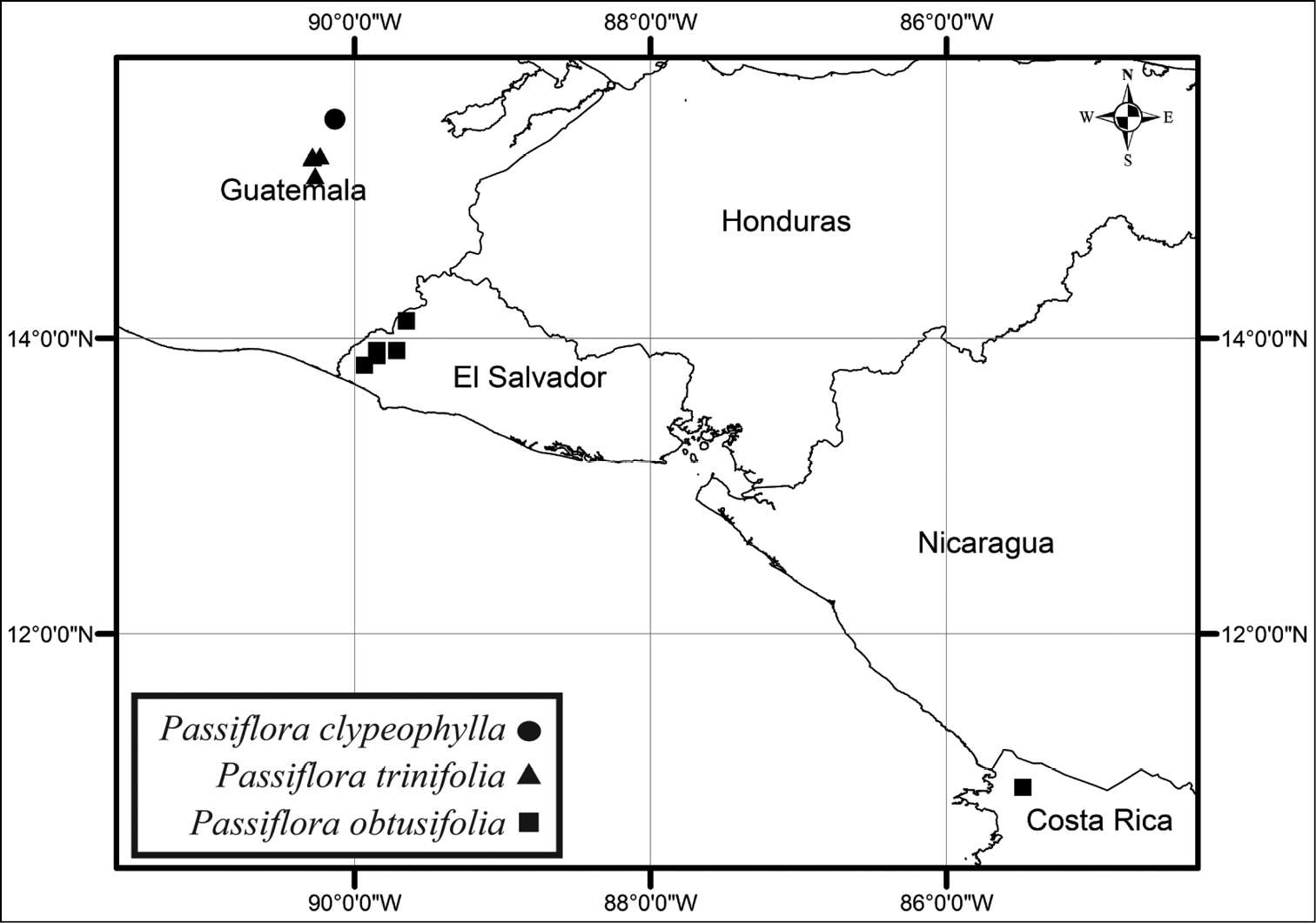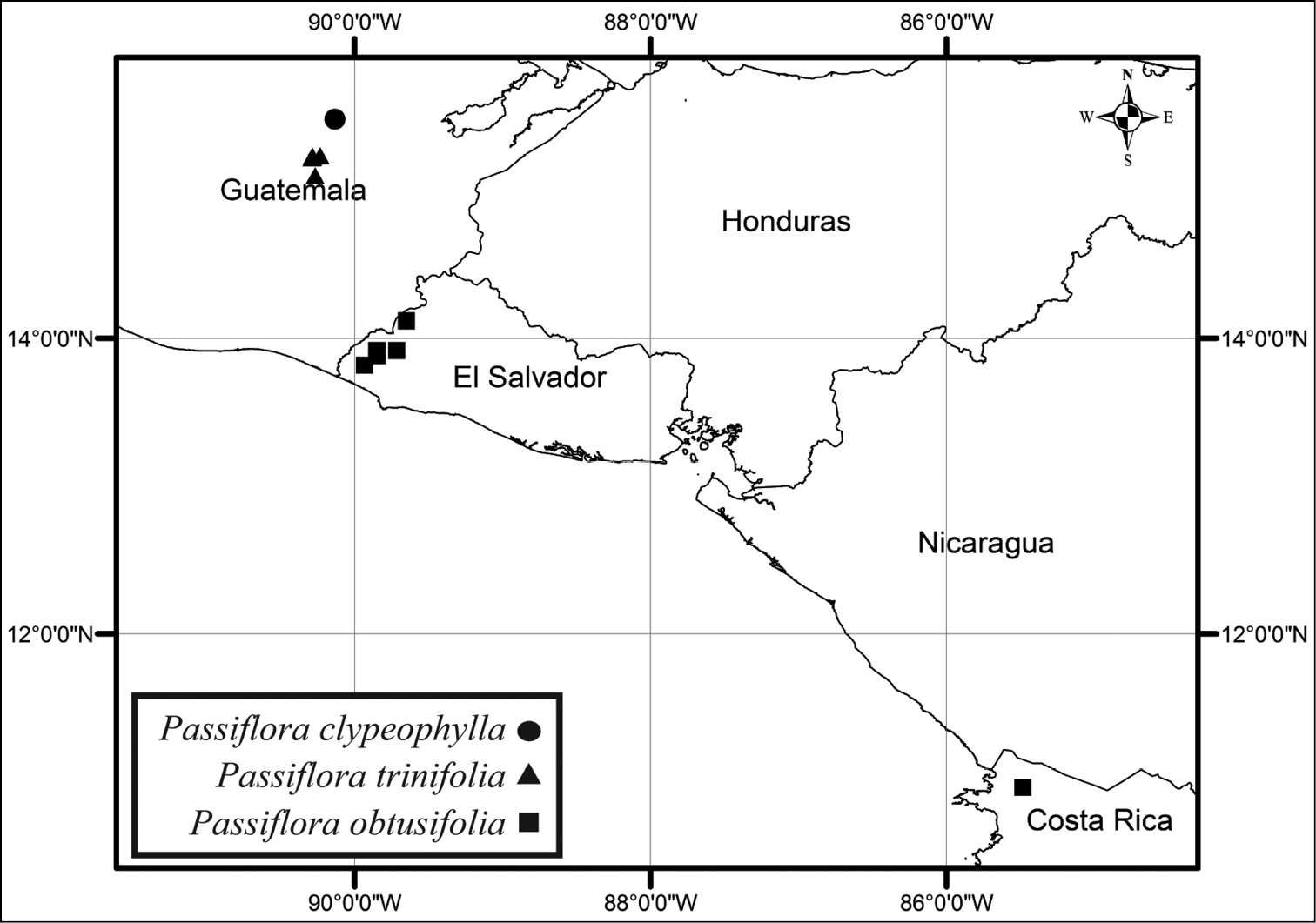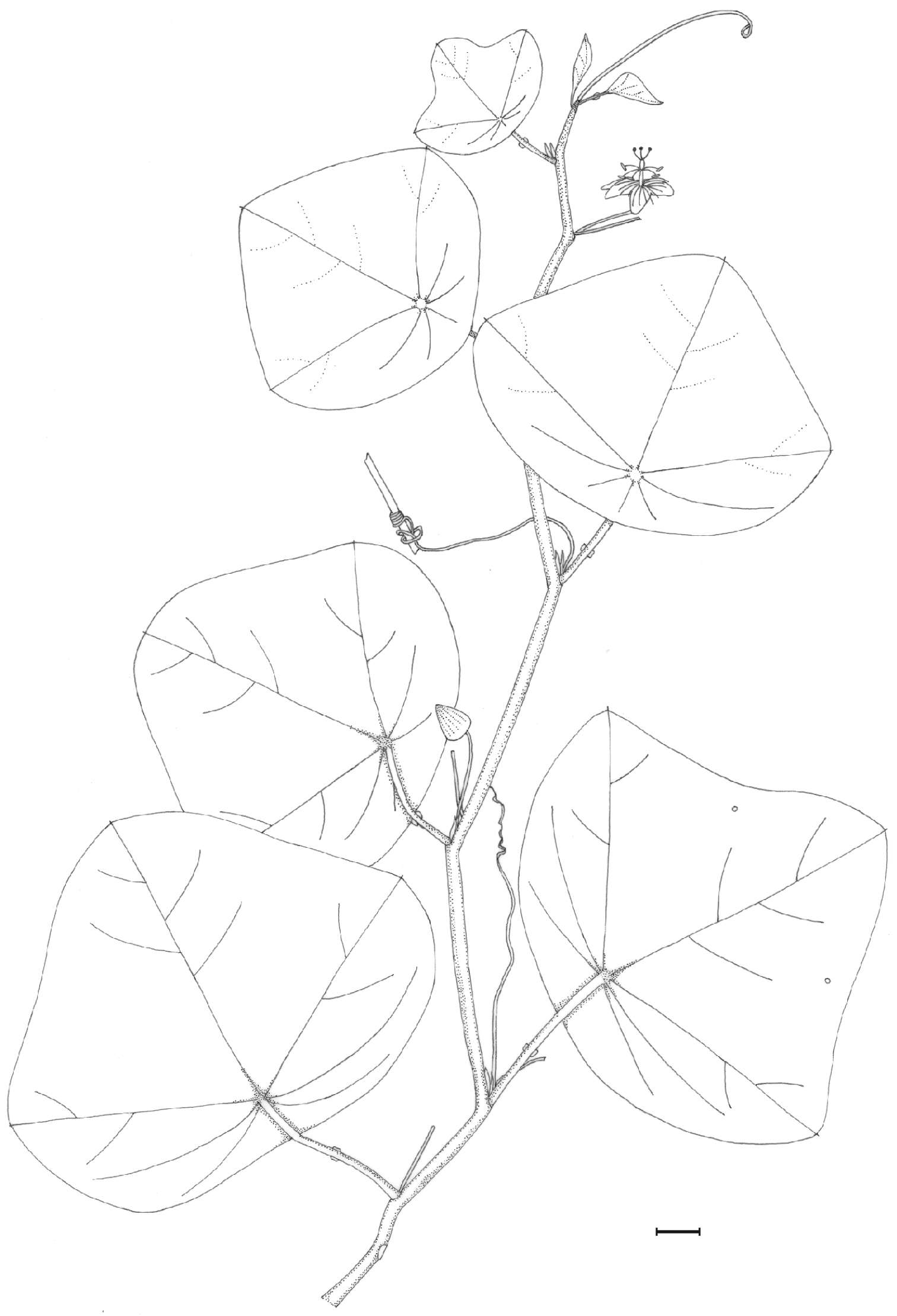-
Rafael F. Almeida, Isabel R. Guesdon, Marcelo R. Pace, Renata M.S. Meira
Phytokeys
Figure 11.
Distribution map of Mcvaughia: triangle – M.bahiana, circle – M.piauhiensis, and square – M.sergipana. Solid blue line in the center represents the São Francisco River today. Dotted blue line represents the past course of São Francisco River. Blue circle represents the São Francisco paleo lake. Light green – Atlantic Forest domain, dark green – Amazon Forest domain, orange – Cerrado domain, and yellow – Caatinga domain. AL – state of Alagoas, BA – state of Bahia, CE – state of Ceará, MA – state of Maranhão, PB – state of Paraíba, PE – state of Pernambuco, PI – state of Piauí, RN – state of Rio Grande do Norte, and SE – state of Sergipe.
-
Rafael F. Almeida, Isabel R. Guesdon, Marcelo R. Pace, Renata M.S. Meira
Phytokeys
Figure 1.
Wood anatomy of Mcvaughiasergipana. A–B transverse sections: Growth rings marked by radially narrow fibers (arrowheads) and a discontinuous line of axial parenchyma (in B); vessels are narrow and abundant, arranged in radial rows of 4 or more cells; some solitary vessels present; parenchyma rare, paratracheal scanty or at the growth ring limits; heartwood vessels in the bottom with content C radial section: Rays 2–3 cells wide, non-storied; prismatic crystals present in ray cells (arrows); parenchyma with 3 cells per strand (arrowhead) D ray heterocellular with procumbent, square and upright cells mixed throughout the ray. Scale bars: 150 μm (A), 100 μm (B–C), 60 μm (D).
-
Rafael F. Almeida, Isabel R. Guesdon, Marcelo R. Pace, Renata M.S. Meira
Phytokeys
Figure 2.
Secondary phloem of Mcvaughiasergipana. A–C Transverse section: A Phloem non-stratified, with scattered fiber-sclereids (arrows); Rays dilating slightly B Crystalliferous axial parenchyma arranged in diffuse-in-aggregate narrow bands (arrowhead) C Crystalliferous axial parenchyma with druse crystals, forming diffuse in aggregate bands, isolated fiber-sclereids present (arrowhead) D A ray 3 cells wide, fiber-sclereids and axial parenchyma in tangential section E Bands of crystalliferous parenchyma with druses evident also in radial section; Rays heterocellular mixed. Scale bars: 200 μm (A), 100 μm (B–C, E), 50 μm (D).
-
Rafael F. Almeida, Isabel R. Guesdon, Marcelo R. Pace, Renata M.S. Meira
Phytokeys
Figure 3.
Leaf morphoanatomy of Mcvaughia species. A patterns of leaf glands distribution on the abaxial leaf surface of M.bahianaB patterns of leaf glands distribution on the abaxial leaf surface of M.piauhiensisC patterns of leaf glands distribution on the abaxial leaf surface of M.sergipanaD transverse section of leaf base showing the basilaminar pair of stalked glands (white arrows) E basilaminar leaf gland with a stalk (black arrow) in M.piauhiensisF basilaminar gland in M.sergipana showing a sessile position (SE= anatomical arrangement with secretory epidermis, SP= vascularized secretory parenchyma) G–H laminar glands on the apex of cleared leaves of M.sergipana and M.bahiana respectively, note the apical tooth (G) I sessile laminar glands in M.sergipanaJ stalked laminar gland in M.piauhiensisK–L transverse sections of the leaf blade; mesophyll with uniserial palisade-like parenchyma and spongy parenchyma composed by several or few layers in M.sergipana and M.bahiana, respectively; note the idioblast with druse crystals at the mesophyll (white arrow) and the stomata distribution at the abaxial leaf surface (black arrow) M–N adaxial epidermis surface of M.piauhiensis and M.sergipana, showing scars of malpighiaceous trichomes O abaxial epidermis surface of trichomes abundance in M.bahianaP–Q outline of the anticlinal epidermal cell walls: straight in M.sergipana (P) and sinuous in M.bahiana (Q). Laminar scale bars: 1 cm (A–C), 100 μm (D, F–K, N–O), 150 μm (E), 50 μm (L–M, P–Q).
-
Rafael F. Almeida, Isabel R. Guesdon, Marcelo R. Pace, Renata M.S. Meira
Phytokeys
Figure 4.
Reproductive morphoanatomy of Mcvaughia species. A inflorescence during development, showing a bracteole gland (BG) and Sepal glands (SG) B ten sepal glands encircling the calyx C Petal glands (PG) along the margin of posterior petal D–F transverse section of bracteole glands in M.sergipana, M.bahiana and M.piauhiensis, respectively G anatomical arrangement of bracteole gland, with a palisade-like secretory epidermis (SE) and secretory parenchyma (SP) H–I transverse section of floral bud and anthesis flower in Mcvaughiabahiana and M.sergipana; calyx gland pair displaced at the anterior sepal J calyx gland structure, showing a secretory epidermis (SE) and vascularized secretory parenchyma (SP) K–L petal glands on the margin of petals in M.sergipana and M.bahiana respectively M–N detail of the petal glands at the apex of the petal limb in M.sergipana, cleared and in SEM image O–Q petal glands positioned at the base, M.bahiana on SEM image, M.bahiana and M.piauhiensis cleared R–T conspicuous and stalked petal glands at the base of M.sergipana, in SEM image, cleared and longitudinal section. Scale bars: 200 μm (D), 150 μm (E–F), 50 μm (G), 500 μm (H–I), 100 μm (J, P–S), 300 μm (L–M), 200 μm (N, T).
-
Rafael F. Almeida, Isabel R. Guesdon, Marcelo R. Pace, Renata M.S. Meira
Phytokeys
Figure 5.
Mcvaughiabahiana. A shrub habit B subshrub habit C inflorescence showing glandular bracts D inflorescence showing flowers in anthesis E inflorescence showing immature and mature fruits F detail of mature fruits G drupe indumentum H glabrescent drupe. A, D–H by W.R. Anderson B–C by I.R. Guesdon.
-
Rafael F. Almeida, Isabel R. Guesdon, Marcelo R. Pace, Renata M.S. Meira
Phytokeys
Figure 6.
Photograph of the isotype of Mcvaughiabahiana.
-
Rafael F. Almeida, Isabel R. Guesdon, Marcelo R. Pace, Renata M.S. Meira
Phytokeys
Figure 11.
Distribution map of Mcvaughia: triangle – M.bahiana, circle – M.piauhiensis, and square – M.sergipana. Solid blue line in the center represents the São Francisco River today. Dotted blue line represents the past course of São Francisco River. Blue circle represents the São Francisco paleo lake. Light green – Atlantic Forest domain, dark green – Amazon Forest domain, orange – Cerrado domain, and yellow – Caatinga domain. AL – state of Alagoas, BA – state of Bahia, CE – state of Ceará, MA – state of Maranhão, PB – state of Paraíba, PE – state of Pernambuco, PI – state of Piauí, RN – state of Rio Grande do Norte, and SE – state of Sergipe.
-
Rafael F. Almeida, Isabel R. Guesdon, Marcelo R. Pace, Renata M.S. Meira
Phytokeys
Figure 3.
Leaf morphoanatomy of Mcvaughia species. A patterns of leaf glands distribution on the abaxial leaf surface of M.bahianaB patterns of leaf glands distribution on the abaxial leaf surface of M.piauhiensisC patterns of leaf glands distribution on the abaxial leaf surface of M.sergipanaD transverse section of leaf base showing the basilaminar pair of stalked glands (white arrows) E basilaminar leaf gland with a stalk (black arrow) in M.piauhiensisF basilaminar gland in M.sergipana showing a sessile position (SE= anatomical arrangement with secretory epidermis, SP= vascularized secretory parenchyma) G–H laminar glands on the apex of cleared leaves of M.sergipana and M.bahiana respectively, note the apical tooth (G) I sessile laminar glands in M.sergipanaJ stalked laminar gland in M.piauhiensisK–L transverse sections of the leaf blade; mesophyll with uniserial palisade-like parenchyma and spongy parenchyma composed by several or few layers in M.sergipana and M.bahiana, respectively; note the idioblast with druse crystals at the mesophyll (white arrow) and the stomata distribution at the abaxial leaf surface (black arrow) M–N adaxial epidermis surface of M.piauhiensis and M.sergipana, showing scars of malpighiaceous trichomes O abaxial epidermis surface of trichomes abundance in M.bahianaP–Q outline of the anticlinal epidermal cell walls: straight in M.sergipana (P) and sinuous in M.bahiana (Q). Laminar scale bars: 1 cm (A–C), 100 μm (D, F–K, N–O), 150 μm (E), 50 μm (L–M, P–Q).
-
Rafael F. Almeida, Isabel R. Guesdon, Marcelo R. Pace, Renata M.S. Meira
Phytokeys
Figure 4.
Reproductive morphoanatomy of Mcvaughia species. A inflorescence during development, showing a bracteole gland (BG) and Sepal glands (SG) B ten sepal glands encircling the calyx C Petal glands (PG) along the margin of posterior petal D–F transverse section of bracteole glands in M.sergipana, M.bahiana and M.piauhiensis, respectively G anatomical arrangement of bracteole gland, with a palisade-like secretory epidermis (SE) and secretory parenchyma (SP) H–I transverse section of floral bud and anthesis flower in Mcvaughiabahiana and M.sergipana; calyx gland pair displaced at the anterior sepal J calyx gland structure, showing a secretory epidermis (SE) and vascularized secretory parenchyma (SP) K–L petal glands on the margin of petals in M.sergipana and M.bahiana respectively M–N detail of the petal glands at the apex of the petal limb in M.sergipana, cleared and in SEM image O–Q petal glands positioned at the base, M.bahiana on SEM image, M.bahiana and M.piauhiensis cleared R–T conspicuous and stalked petal glands at the base of M.sergipana, in SEM image, cleared and longitudinal section. Scale bars: 200 μm (D), 150 μm (E–F), 50 μm (G), 500 μm (H–I), 100 μm (J, P–S), 300 μm (L–M), 200 μm (N, T).
-
Rafael F. Almeida, Isabel R. Guesdon, Marcelo R. Pace, Renata M.S. Meira
Phytokeys
Figure 9.
Mcvaughiasergipana. A sandy dune where M.sergipana occurs B detail of epipetiolar stipules C detail of leaf venation patterns D abaxial surface of a leaf E inflorescence showing buds and flowers F detail of glandular bracts G floral bud H flower in frontal view I fruit in side view. Photos by R.F. Almeida.
-
Rafael F. Almeida, Isabel R. Guesdon, Marcelo R. Pace, Renata M.S. Meira
Phytokeys
Figure 10.
Photograph of the isotype of Mcvaughiasergipana.
-
Rafael F. Almeida, Isabel R. Guesdon, Marcelo R. Pace, Renata M.S. Meira
Phytokeys
Figure 11.
Distribution map of Mcvaughia: triangle – M.bahiana, circle – M.piauhiensis, and square – M.sergipana. Solid blue line in the center represents the São Francisco River today. Dotted blue line represents the past course of São Francisco River. Blue circle represents the São Francisco paleo lake. Light green – Atlantic Forest domain, dark green – Amazon Forest domain, orange – Cerrado domain, and yellow – Caatinga domain. AL – state of Alagoas, BA – state of Bahia, CE – state of Ceará, MA – state of Maranhão, PB – state of Paraíba, PE – state of Pernambuco, PI – state of Piauí, RN – state of Rio Grande do Norte, and SE – state of Sergipe.
-
Rafael F. Almeida, Isabel R. Guesdon, Marcelo R. Pace, Renata M.S. Meira
Phytokeys
Figure 3.
Leaf morphoanatomy of Mcvaughia species. A patterns of leaf glands distribution on the abaxial leaf surface of M.bahianaB patterns of leaf glands distribution on the abaxial leaf surface of M.piauhiensisC patterns of leaf glands distribution on the abaxial leaf surface of M.sergipanaD transverse section of leaf base showing the basilaminar pair of stalked glands (white arrows) E basilaminar leaf gland with a stalk (black arrow) in M.piauhiensisF basilaminar gland in M.sergipana showing a sessile position (SE= anatomical arrangement with secretory epidermis, SP= vascularized secretory parenchyma) G–H laminar glands on the apex of cleared leaves of M.sergipana and M.bahiana respectively, note the apical tooth (G) I sessile laminar glands in M.sergipanaJ stalked laminar gland in M.piauhiensisK–L transverse sections of the leaf blade; mesophyll with uniserial palisade-like parenchyma and spongy parenchyma composed by several or few layers in M.sergipana and M.bahiana, respectively; note the idioblast with druse crystals at the mesophyll (white arrow) and the stomata distribution at the abaxial leaf surface (black arrow) M–N adaxial epidermis surface of M.piauhiensis and M.sergipana, showing scars of malpighiaceous trichomes O abaxial epidermis surface of trichomes abundance in M.bahianaP–Q outline of the anticlinal epidermal cell walls: straight in M.sergipana (P) and sinuous in M.bahiana (Q). Laminar scale bars: 1 cm (A–C), 100 μm (D, F–K, N–O), 150 μm (E), 50 μm (L–M, P–Q).
-
Rafael F. Almeida, Isabel R. Guesdon, Marcelo R. Pace, Renata M.S. Meira
Phytokeys
Figure 4.
Reproductive morphoanatomy of Mcvaughia species. A inflorescence during development, showing a bracteole gland (BG) and Sepal glands (SG) B ten sepal glands encircling the calyx C Petal glands (PG) along the margin of posterior petal D–F transverse section of bracteole glands in M.sergipana, M.bahiana and M.piauhiensis, respectively G anatomical arrangement of bracteole gland, with a palisade-like secretory epidermis (SE) and secretory parenchyma (SP) H–I transverse section of floral bud and anthesis flower in Mcvaughiabahiana and M.sergipana; calyx gland pair displaced at the anterior sepal J calyx gland structure, showing a secretory epidermis (SE) and vascularized secretory parenchyma (SP) K–L petal glands on the margin of petals in M.sergipana and M.bahiana respectively M–N detail of the petal glands at the apex of the petal limb in M.sergipana, cleared and in SEM image O–Q petal glands positioned at the base, M.bahiana on SEM image, M.bahiana and M.piauhiensis cleared R–T conspicuous and stalked petal glands at the base of M.sergipana, in SEM image, cleared and longitudinal section. Scale bars: 200 μm (D), 150 μm (E–F), 50 μm (G), 500 μm (H–I), 100 μm (J, P–S), 300 μm (L–M), 200 μm (N, T).
-
Figure 9.The first of three most parsimonious trees from the ITS-1 and ITS-2 data set of Passiflora supersection Cieca and outgroups. Numbers above branches are branch lengths. Bootstrap values are given below corresponding branches. Tree length = 590; CI = 0.636; RI = 0.837; RC = 0.532. Names followed by the letters “a”, “b”, “c”, “d”, and “e” denote clones of the same individual from a particular locality.
-
Figure 34.Flower and leaf of Passiflora tenuiloba (MacDougal 227) Scale bar = 6.0 mm. Photo by J. M. MacDougal.
-
Figure 35.Distribution of Passiflora tenuiloba.
-
Figure 36.Flower and leaves of Passiflora eglandulosa (MacDougal 6237). a Flower and flower buds. Scale bar = 3 mm b Leaves, stem and flower buds. Scale bar = 3 mm. Photos by J. M. MacDougal.
-
Figure 37.Distribution of Passiflora eglandulosa.
-
Figure 38.Flower, immature fruits, and leaves of Passiflora trinifolia a Immature fruits (MacDougal 6223) Scale bar = 10 mm. Photo by J. M. MacDougal b Plant habit (MacDougal 6223) Photo by J. M. MacDougal c Flower (MacDougal 637GR) Scale bar = 5.0 mm. Photo by J. M. MacDougal.
-
Figure 39.Distribution of Passiflora clypeophylla, Passiflora trinifolia, and Passiflora obtusifolia.
-
Figure 39.Distribution of Passiflora clypeophylla, Passiflora trinifolia, and Passiflora obtusifolia.
-
Figure 40.Habit of Passiflora clypeophylla (based upon Smith 1625) Scale bar = 1.0 cm.


